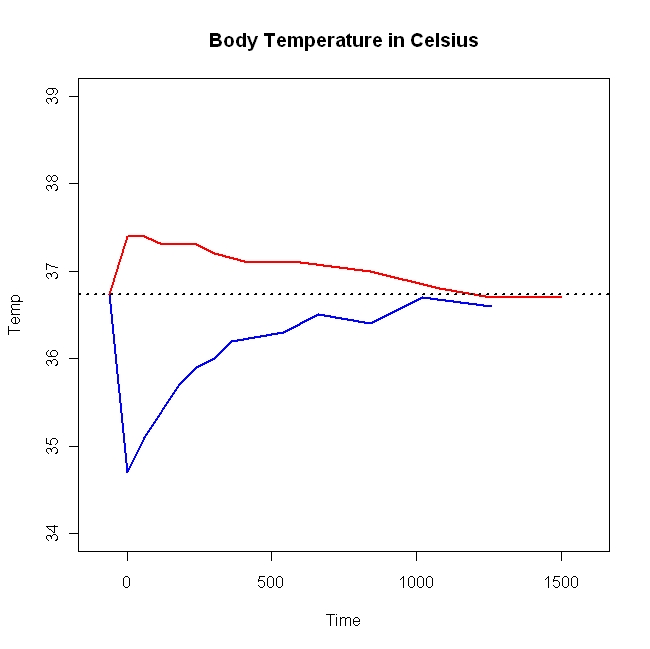
Scientific Studies the world can do without |
Body
Temperature:
The STE Effect
|
Have you ever wondered how accurate the measurement of your temperature
actually is?
Imagine that you just had a nice cool drink from your mother but a few minutes
later she wants to take your temperature AGAIN.
Later that evening, after having a nice chicken broth for dinner, it's time for a last
measurement. ... Well, it COULD be that the things you've devoured right before the measurement might have an influence to the local temperature in your mouth. Why not? After all we all know that things can be heated up and then will cool down following a negative exponential curve. 'Right', one might say, 'but the human body is not a 'thing'. It's living tissue that controls its own temperature quite successfully. At least we do not FEEL that our mouth is colder than usual after a cool drink, do we?' To clarify this lets do a little experiment. The following graph shows my temperature take in intervals after having a piece of hot apple pie (red) and after half a glas of icewater (blue). The dotted horizontal line represents my average temperature taken four times right before the experiments. 
As you can see the temperature sharply jumps +0.7 (red) and -2.0 (blue) degrees right after
the intake of warm and cold substances respectively.
After that it takes a rather long delay (about 1000sec)
until the temperature returns to the average value. Now, if STE is indeed a negative exponential decrement (at least that's what it looks like),
T(t) = T_aver + T_0 * exp[ -t/tau ]
with: T_aver = average temperature
T_0 = temperature deviation at time 0
tau = time constant
then there are two things to learn:
So, what can we learn from these premises:
If we want to achieve reliable measurements, it follows that deviations caused by prior
intake of food or beverages should not influence the measurement more than the assumed accuracy
of the thermometer itself. Most manufacturers claim that their thermometers are exact to less than
0.05 degrees celsius (not taking into account all the errors that may be caused by inproper
placement).
Unfortunately this means that the minimum time period
t_min = - tau * ln[ 0.05/T_0 ]
This is rather impractical because we don't know what T_0 is without an extra
measurement. Therefore lets simplify by using the worst-case-scenario of T_0 = 3 degrees(I doubt that we can actually achieve that; at least not on the warm side!).
Then
t_min = - 200 * ln[ 0.05 / 3.0 ] = 818sec
To conclude: From the observed SET effect it follows deductively that Moms should always allow a time period of at least 818 seconds after any food or beverage intake before taking the temperature. |
Coming Next:
Alcotester:
Myth or
Measurement?
|
Have you ever been checked for alcoholic intoxication? Usually the law officer
asks you (more or less politely) to give a good blow into a tube
connected to a so called alcotester device ('alcotest' is the trademark of
Dräger Savety). Manufactorers of alcotester devices claim that these show an accuracy of +/-5%, but this does not mean the accuracy of the resulting BAC but the accuracy regarding the BRAC. There remains the problem whether the relationship between BRAC and BAC may be distorted by other factors.
A major factor is alcohol that remains in the mouth after consumation
which consequently increases the BRAC considerably. Therefore an alcotester
must not be used before a minimum waiting period of 20min after the last
alcohol intake. If this period is not maintained the results are not
admissibly at court (in most cases not even after that, depending on
your judical system). So, the basic question here is: What are the chances that the alcotester reports a significant BRAC value while in reality you're totally sober but happens to be lightly build, or female, or a senior, or ... ? As always, lets do a little experiment ...
I went to several Bavarian beer parties during the last decade and asked folks there
whether they would be willing to assist science by donating a blood sample.
A law officer (who happens to be a buddy of mine) brought one of these professional
alcotesters and took a measurement from all volunteers, while a real
(and sober) doctor (who happens to be another ...) took a blood sample
right after the breath alcohol test. Of course we also registered age, gender,
height and weight (and for the attractive female participants we also asked
for the phone number; just in case). |
Copyright 2009 Florian Schiel
Impressum: Florian Schiel, Moltkestr. 1, D-80803 München,
Germany, schiel@bas-services.de
.